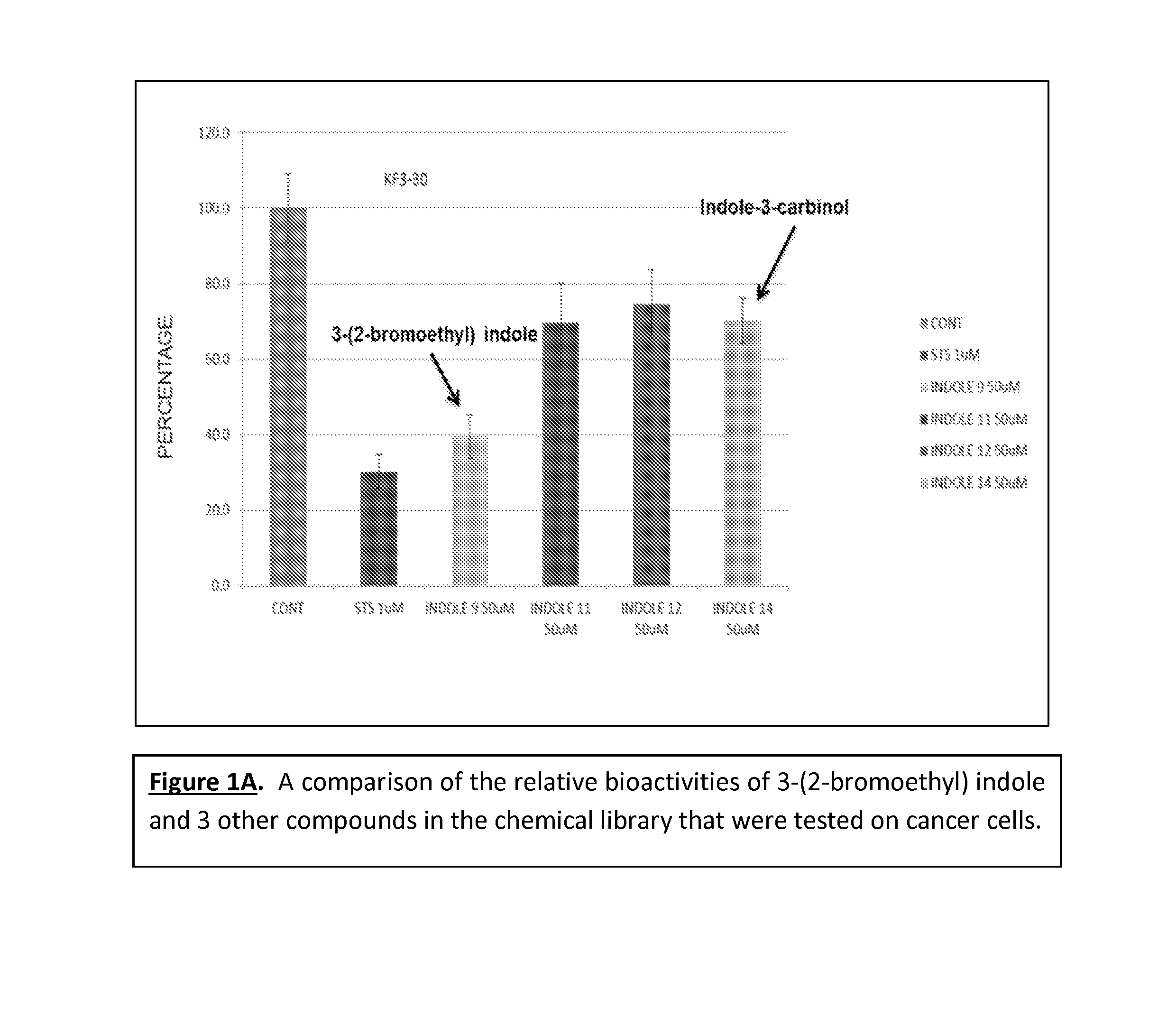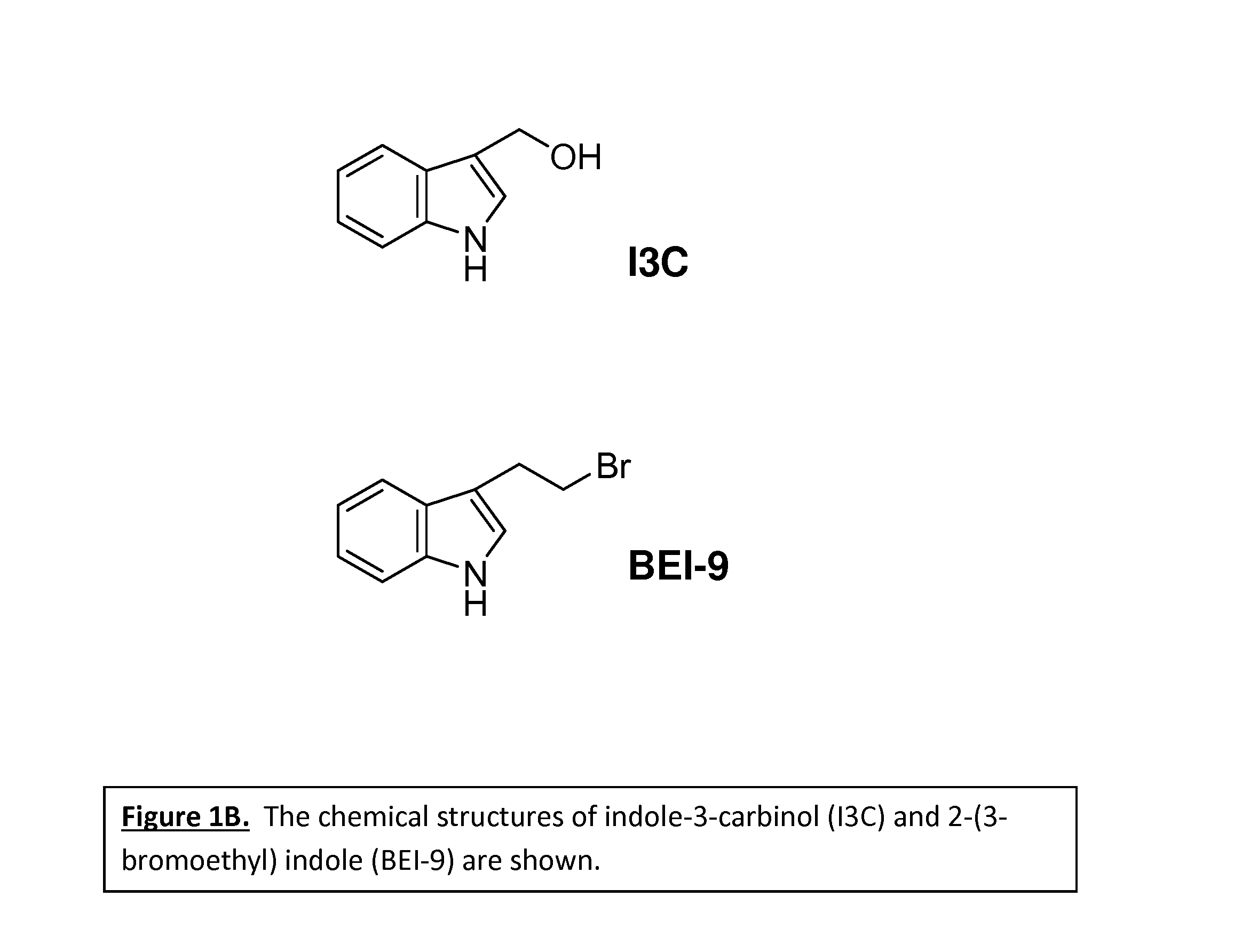Anticancer treatment methods involving analogs and derivatives of 3-(2-substituted-ethyl) indole compounds
a technology of indole and derivatives, which is applied in the field of anticancer treatment methods involving analogs and derivatives of 3(2substitutedethyl) indole compounds, can solve the problems of limited and inconsistent research on the inverse correlation between indole-3-carbinol and the viability of cancer cells
- Summary
- Abstract
- Description
- Claims
- Application Information
AI Technical Summary
Benefits of technology
Problems solved by technology
Method used
Image
Examples
example 1
3-(2-bromoethyl) indole is more potent than indole-3-carbinol
[0033]SW480 colon cancer cells were treated with solvent DMSO (CONT), staurosporine (STS)—an agent that is known to kill cancer cells—and four select indole derivative compounds. Cell viability and proliferation was examined under a MTT assay protocol. FIG. 1A shows the relative viability / proliferation index of the select indole compounds as compared to the control solvent. The control solvent is shown as in FIG. 1A as the bar corresponding to “CONT.” When treated with only the control solvent, the cancer cells are 100% viable. Yet, according to FIG. 1A, treating cancer cells with 3-(2-bromoethyl) indole reduces cancer cell viability and proliferation by about 60% within 48 hours. As noted in FIG. 1A, 3-(2-bromoethyl) indole is represented by “INDOLE 9.” By comparison, a similar concentration of indole-3-carbinol reduces cell proliferation only by about 30%. As noted in FIG. 1A, indole-3-carbinol is represented by “INDOLE ...
example 2
3-(2-Bromoethyl) Indole Markedly Inhibits Cell Proliferation
[0034]SW480 colon cancer cells were treated with either vehicle control (DMSO) or 25 μM 3-(2-bromoethyl) indole. As shown in FIG. 2, microscopic evaluation of treated cells revealed that 3-(2-bromoethyl) indole-treated cells failed to multiply and populate the cell culture dish surface. By comparison, vehicle-treated cells rapidly proliferated and visibly filled the surface on which they were seeded. Microphotographs were taken 24 hours (a and c) and 48 hours (b and d) after the treatments. FIG. 2 indicates that the vehicle-treated control cells multiplied and filled out the growth surface, whereas those treated with 3-(2-bromoethyl) indole did not show any sign of proliferation, thus evidencing the growth inhibitory activity of the 3-(2-bromoethyl) indole. To further examine the possibility of inhibited cell proliferation, cell cycle analysis was performed by flow cytometry on cells that were treated with 50 μM 3-(2-bromoe...
example 3
Bioactivity Depends on the Dose of 3-(2-Bromoethyl) Indole
[0035]Increasing concentrations of 3-(2-bromoethyl) indole (from 12.5 μM to 100 μM) were tested on SW480 colon cancer cells, and viability of the treated cells was measured by the CellTiter-Glo® (Promega® Corporation) method. FIG. 4 shows that marked (about 50%) reduction in cell viability was attained even when merely treating SW480 cancer cells with 12.5 μM 3-(2-bromoethyl) indole. The fact that the lowest concentration tested exhibited a marked reduction in cancer cell viability indicates a strong bioactivity of the compound. Similarly, dose response examination and cell cycle analysis using variable concentrations of 3-(2-bromoethyl) indole ranging from 12.5 to 100 μM confirms that even doses lower than 50 μM inhibit cell proliferation. See FIGS. 3B and 5. Thus, useful embodiments of the present invention provide for a method of inhibiting cancer cell proliferation, comprising treating the cancer cells with 3-(2-bromoethy...
PUM
| Property | Measurement | Unit |
|---|---|---|
| wavelength | aaaaa | aaaaa |
| concentration | aaaaa | aaaaa |
| bioactive | aaaaa | aaaaa |
Abstract
Description
Claims
Application Information
 Login to View More
Login to View More - R&D
- Intellectual Property
- Life Sciences
- Materials
- Tech Scout
- Unparalleled Data Quality
- Higher Quality Content
- 60% Fewer Hallucinations
Browse by: Latest US Patents, China's latest patents, Technical Efficacy Thesaurus, Application Domain, Technology Topic, Popular Technical Reports.
© 2025 PatSnap. All rights reserved.Legal|Privacy policy|Modern Slavery Act Transparency Statement|Sitemap|About US| Contact US: help@patsnap.com



